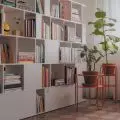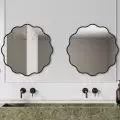Čoarvemátta cultural and educational center,
designed by Snøhetta, 70°N Arkitektur, Joar Nango
In 2021, Snøhetta, in cooperation with 70°N Arkitektur and architect Joar Nango, presented the winning entry in an architectural competition for a new Lapland theater connected to a school building. The opening of this facility took place this year.
Bird's-eye view - all elevations of the building harmoniously relate to the surrounding landscape, adapting their proportions and organic forms to the hills
© Snøhetta
Symbolism of the name: horn and root
as a metaphor for unity
The name Čoarvemátta comes from the language of the Saami people, who live in Lapland, and means horn and root, referring to the innermost and strongest part of the reindeer's antlers. It symbolizes qualities such as endurance and unity, which will unite the institutions sharing the building: the Sami National Theater Beaivváš and the Sami Reindeer High School and Reindeer Herding School.
The exterior space has been planned to protect against wind and harsh weather conditions, increasing comfort and functionality
© Snøhetta
We are proud to have contributed to the construction of this long-awaited and important building. The theater combined with the reindeer herding school provides a wonderful program for the architect to work on. It is a testament to good architecture that two seemingly unrelated institutions have been successfully combined. The project also provides an exceptional use of resources that play an important role in the traditional Sami craft of duodji. In this context, an important principle is that anything that comes from an animal can be used for something - skin, nostrils and horn
- says Kjetil Trædal Thorsen, founder of Snøhetta.
The space, designed with sharing in mind, aims to integrate different social groups and enable collaboration in education and culture
© Snøhetta
architecture in harmony
with the norwegian landscape
The new building is located in Kautokeino, in the heart of Finnmarksvidda, Norway's largest and northernmost plateau. All four elevations of the building relate to the surrounding landscape spaces in a variety of ways. The building has been designed to harmonize with the surrounding hills, and its proportions have been adjusted to the context so that it does not have sharp angles that would interfere with the organic forms. The gabled roof on the north and south sides minimizes the visual height of the building when viewed from a distance.
A view from afar, where Čoarvemátta subtly hides in the surrounding vegetation, creating a harmonious whole with the natural landscape by using materials that harmonize with the surroundings
© Snøhetta
A branching space shared by the school and the theater
inspired by Sami tradition
The common space has an irregular shape (consisting of three arms), with the main entrance and vestibule located in the center, creating a meeting place for users.
Čoarvemátta plan - shows the irregular shape of the building
© Snøhetta
From here, the body of the building extends in three directions - one wing for the theater, another for workshop space and teaching rooms, and a third for the school's administration. The curved lines, vestibule with skylights, chimney opening and prominent wooden support structure are inspired by traditional Sami buildings, typical of areas associated with reindeer herding.
A bird's-eye view showing the characteristic branched shape of Čoarvemátta
© Snøhetta
use of materials
- locally and ecologically
The building's facade is made of wood - red pine. The massive 4930 m² roof is finished with wooden planks. The slate stone on the theater's gable wall comes from the village 's old school, which was demolished. Inside the vestibule and corridors, polished concrete floors mimic the building's surroundings, using locally quarried stone such as slate and quartzite in various shades of gray and green.
The building's gabled roof, with an impressive surface, is covered with wooden planks
© Snøhetta
Čoarvemátta color scheme
- from warmth to coolness
The central part of the building, around the foyer, atrium and theater halls, is painted in warm red tones. As you move away from this central point, it becomes cooler, with bluish tones at the ends of the building's arms. The contrasts between the doors, walls and floors in different colors allude to the Sami use of colors, creating a strong contrast with the exterior of the building, which is covered in snow for most of the year.
The interior of the building, with its walls in warm red tones and natural wood, exudes a cozy and harmonious atmosphere
© Snøhetta
three interaction zones
- space for the school and theater
The branching shape of the building naturally creates three outdoor spaces. The south side is the main entrance and the plaza in front of the building. The courtyard is intimate and circular, with a gazebo, a fireplace, stone seating and an amphitheater. The stones for the seating come from a nearby plateau, and the neutrality of the space makes it suitable for use by both the school and the theater.
The roof minimizes the visual height of the structure and emphasizes the organic character of the whole building
© Snøhetta
functionality of the outdoor space
- sheltered workspace
The outdoor space located on the other side of the theater wing has been designated for workshops and is visually sheltered from the frequent wind and harsh weather conditions of Finnmarksvidda. To the north of the building are areas designated for reindeer fencing, which is related to their breeding at the facility. On the east side, the plateau blends harmoniously with the building, with the terrain and vegetation preserved almost intact.
A view of Čoarvemátta's minimalist gabled roof
© Snøhetta
eco-architecture in action
- How Čoarvemátta combines functionality with nature
Čoarvemátta has low energy requirements, and the building is 90 percent energy self-sufficient. On the construction site, the soil that had to be removed was carefully preserved and the top layer temporarily stored, to be later restored to all surfaces around the building, keeping the seed supply intact.
The space, designed with shared use in mind, aims to integrate different social groups and enable collaboration in education and culture
© Snøhetta
Compiled by Anastazja Dżupina
Illustrations provided courtesy of Snøhetta studio.















































